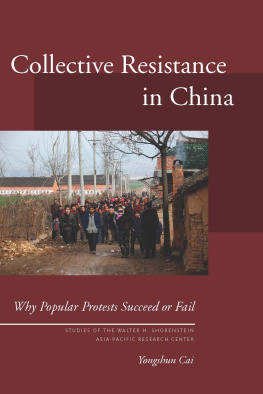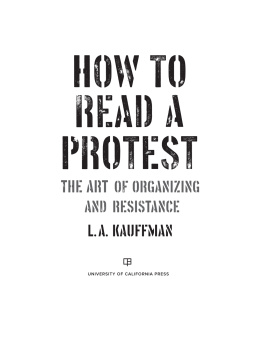Yongshun Cai - Collective Resistance in China: Why Popular Protests Succeed or Fail
Here you can read online Yongshun Cai - Collective Resistance in China: Why Popular Protests Succeed or Fail full text of the book (entire story) in english for free. Download pdf and epub, get meaning, cover and reviews about this ebook. year: 2010, publisher: Stanford University Press, genre: Politics. Description of the work, (preface) as well as reviews are available. Best literature library LitArk.com created for fans of good reading and offers a wide selection of genres:
Romance novel
Science fiction
Adventure
Detective
Science
History
Home and family
Prose
Art
Politics
Computer
Non-fiction
Religion
Business
Children
Humor
Choose a favorite category and find really read worthwhile books. Enjoy immersion in the world of imagination, feel the emotions of the characters or learn something new for yourself, make an fascinating discovery.
- Book:Collective Resistance in China: Why Popular Protests Succeed or Fail
- Author:
- Publisher:Stanford University Press
- Genre:
- Year:2010
- Rating:4 / 5
- Favourites:Add to favourites
- Your mark:
- 80
- 1
- 2
- 3
- 4
- 5
Collective Resistance in China: Why Popular Protests Succeed or Fail: summary, description and annotation
We offer to read an annotation, description, summary or preface (depends on what the author of the book "Collective Resistance in China: Why Popular Protests Succeed or Fail" wrote himself). If you haven't found the necessary information about the book — write in the comments, we will try to find it.
Yongshun Cai: author's other books
Who wrote Collective Resistance in China: Why Popular Protests Succeed or Fail? Find out the surname, the name of the author of the book and a list of all author's works by series.
Collective Resistance in China: Why Popular Protests Succeed or Fail — read online for free the complete book (whole text) full work
Below is the text of the book, divided by pages. System saving the place of the last page read, allows you to conveniently read the book "Collective Resistance in China: Why Popular Protests Succeed or Fail" online for free, without having to search again every time where you left off. Put a bookmark, and you can go to the page where you finished reading at any time.
Font size:
Interval:
Bookmark:

Andrew G. Walder, General Editor
The Walter H. Shorenstein Asia-Pacific Research Center in the Freeman Spogli Institute for International Studies at Stanford University sponsors interdisciplinary research on the politics, economies, and societies of contemporary Asia. This monograph series features academic and policy-oriented research by Stanford faculty and other scholars associated with the Center.
The Chinese Cultural Revolution as History
Ethnic Nationalism in Korea: Genealogy, Politics, and Legacy
Prospects for Peace in South Asia
Stanford, California
No part of this book may be reproduced or transmitted in any form or by any means, electronic or mechanical, including photocopying and recording, or in any information storage or retrieval system without the prior written permission of Stanford University Press.
Printed in the United States of America on acid-free, archival-quality paper
Library of Congress Cataloging-in-Publication Data
Cai, Yongshun.
participationChina. 4. ChinaPolitics and government19762002.
5. ChinaPolitics and government2002I. Title. II. Series: Studies of the
Walter H. Shorenstein Asia-Pacific Research Center.
Typeset by Thompson Type in 11/14 Adobe Garamond
Font size:
Interval:
Bookmark:
Similar books «Collective Resistance in China: Why Popular Protests Succeed or Fail»
Look at similar books to Collective Resistance in China: Why Popular Protests Succeed or Fail. We have selected literature similar in name and meaning in the hope of providing readers with more options to find new, interesting, not yet read works.
Discussion, reviews of the book Collective Resistance in China: Why Popular Protests Succeed or Fail and just readers' own opinions. Leave your comments, write what you think about the work, its meaning or the main characters. Specify what exactly you liked and what you didn't like, and why you think so.












